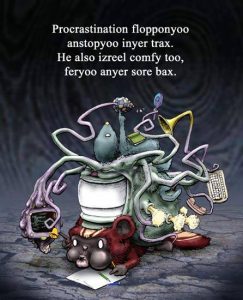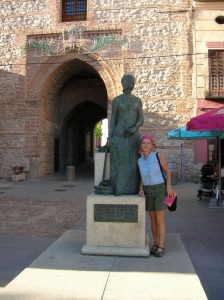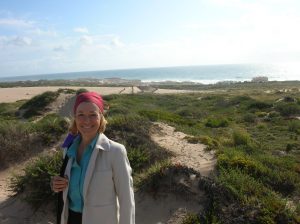Check it out–start to finish! I’ve been working for the last month with Patricia Maas and Gabriel Porras of Blue Jay Technologies to revamp this website to make it more interactive, informative, useful, and fun. Many pages are new, and most of those I’ve retained have changed a little or a lot. Hope you enjoy the visit, and let me know what you think at lacauthor@gmail.com.
Uncategorized
Taking a Breather
I’m procrastinating. I’ve come to a big turning point in my novel in progress and I’m doing everything else I can think of today except write–which accounts for the sudden urge to post something in this diary.
Everything about writing a novel is demanding, but some things are harder than others. Hands down, the most difficult part for me is the opening chapter, because I don’t know the characters all that well, and I don’t yet feel as if I live in their house, in their town, in their era.
As a novel progresses there are other places that present a similar challenge. I’ve written and revised into marketable quality more than 350 pages of the book, but I have now reached the point where my main character has just arrived in a new city with an entirely new set of characters, and furthermore, by the end of this chapter, I’ll be jumping forward in time 5 years and she’ll go to another new town with another new set of characters. It’s almost like starting from scratch except that I know my protagonist now, and all I have to do is supply the people and the situation, and she’ll take over and tell my fingers what to type.
All I have to do? Sounds like a lot to me. Even minor characters need names, personalities and motivations, and places need to be thoroughly imagined–although fortunately, I learned recently, readers don’t necessarily want detailed physical descriptions of every last person and place because they prefer to imagine for themselves.
Luckily for me, before I left off writing, I made notes for this new section, including the main elements of the plot and the characters I would need to carry the plan out. I took a look at these notes–less than a page total–and started thinking, “this is going to be good!” Still, I’ve got the blank page heebie jeebies today, and I’m just going to let them stick around for a while until they get bored and check out of my brain.
it won’t take long for that. It’s an exciting world I’m writing about, with a main character I care deeply for. I can’t wait to see what’s really going to happen. It’s usually far different and better than the notes, and the only way to find out is to start writing.

“Healthy Author” Is Not an Oxymoron
Some famous writers cultivate an image of reckless disregard for their bodies. Some are just plain weird, maladjusted, or out of touch with life in the real world. And some, of course, are best described by all of the above.
I know a lot of writers, and I can attest to how basically normal most of us are. We have to be. We function in an environment that has myriad ways to sap our energy and undermine our egos, and we have to be able to float on top of it all, at least most of the time.
I have been writing for publication for 11 years now (17 YA and 4 adult trade titles). I pulled out a calculator to figure out how many pages of conventionally published writing they all add up to, and I’m astonished that it comes out to somewhere around 4000-4300 pages in books alone, not to mention book reviews, this diary, and other things I’ve written. Interestingly, that comes out, using the low figure, to roughly 365 pages a year, or 1 published page a day for 11 years.
I’m not crowing here. I have been more fortunate in getting published than many of the

talented and committed writers I know. I’m just thinking that this puts me in a pretty good position to comment on how to stay in writing for the long haul, without sacrificing health or sanity (at least I hope most people would agree I haven’t lost the latter).
I’m 300 pages into my novel in progress, and I am trying to learn from how wiggy I’ve gotten in the past, so I can avoid it this time. I’m a professor with summers off, a mixed blessing because the structure of going to work and interacting with a variety of people is good for me. People with different commitments and obligations might have to adjust the details, but I think the principle I’m sharing here is sound for everyone.
In brief, the problem with many writers, especially those who do it for a living, is that we think everything else we do is taking us away from our writing. We don’t like that, so we devalue other things and try to do as little of them as possible when we’re hot in the middle of a project. This is a mistake.
This summer I am telling myself that writing is only one of several good uses of my time, and it is inappropriate to be writing when I should be doing something else. I have a sign near my computer that has a list of 5 things:
Writing
Book Promotion
Exercise
Life Maintenance
R&R
Every one of those things is a valid and necessary part of my day. I plan every day around ensuring that I put in at least an hour on each. Then I fill up the rest of my time with a mix of all of them, in whatever way works that day.
I’m not talking about the 8-hour standard workday, but the whole 12 hours from the time I get up (around 6AM) to the time I call a halt to everything but an evening with my sweetheart (around 6PM). On most days the majority of my time overall is taken up with writing, but as I get more invested in the other things on the list, I often spend more than the minimum on them, and I still have a lot of time to write.
I ask myself a couple of times each day whether I’m doing a good mix of the 5 types of things, and if I’m not, I tell myself “it’s not writing time now.”
Haven’t exercised? Do it! Haven’t taken a shower or gone to the store? Do it. Haven’t stopped just to do something fun? Do it!
I’m having a great summer, and interestingly, I don’t think my writing productivity has dropped overall. I’m still on track to finish novel #4 this fall, and I think I could have finished it only a few weeks earlier at most if I had done nothing else. And I feel great–not at all like that stringy-haired, unwashed, antisocial creature with a backache I vaguely remember from summers past.
I Love My Book!
Writing a novel is such a huge undertaking that writers run the gamut of emotions many times over during the process. I’m sure as the remaining months go by in which I finish up my work in progress, THE SHAPE OF THE WORLD, I will have times when I have doubts not just about what I have written but about whether I am capable of making the book as good as I want it to be. I’ll be amazed by surprises the characters have in store, and saddened and angered by some of the things that must happen to them. (I’d like to keep them all safe and happy, but that’s not the nature of either real or fictional lives.)
I’ve talked in the past in this diary about how writing can be so intimidating that I get scared to open the manuscript file on my computer. It’s hard to “go there” sometimes because the work is so intense and it takes so much out of me. Once I am into it again, I become so compulsive that my life patterns get more out of whack than I want them to. I can’t seem to stop writing, and when I make myself leave the computer, I can’t stop thinking about my book.
I took three weeks off in June to go to Spain and Portugal to research my novel in

progress, and when I returned, family obligations kept me away from my desk for another week. But now I’ve been back on the job for a few days, and to my surprise, I wasn’t hesitant to dive back in. In fact, I couldn’t wait. I already have the first seventy-five pages revised to include material from my travels and other improvements that come from knowing the characters better and seeing more clearly where the story is going.
I already sense the first signals I’m getting weird and compulsive about my novel in progress, but I don’t care. Writing is what I most love to do. And as I said, writers run the gamut of emotions. Right now, I am relishing the fact that I LOVE THIS BOOK! I love the characters, I love the setting, I love the history, I love the message, I love the story.
Hang in there, I tell myself. Charge forward! This can be the best work you’ve ever done. Everything is there. All it takes is me. The computer is glowing. I have a book to write.
Finding the Story in the Place
I’ve written in this diary in the past about how important travel is to getting the details right in historical fiction. It’s exciting to see how accurately I have portrayed some locations just from researching photographs and descriptions of places, and there is also blessed relief in realizing how much embarrassment I may have avoided by being able to correct what was blatantly wrong.
I’ve also been reminded daily on this trip through Spain and Portugal researching THE SHAPE OF THE WORLD (my novel in progress) that a lot of the value in travel isn’t to confirm or correct details but to discover what simply wasn’t knowable without direct experiences of places or chances to talk with local people. About Sagres, for example, I would probably never have known how much of a factor the wind is in everyday life on the southwest tip of Portugal. The hotel clerk told me, “people who live here think something’s wrong when the wind stops blowing.” Just the three days I spent in the area convinced me that the wind needs to be a dominant part of my description of the place.
Yesterday in Arevalo, north of Madrid, where Isabella (of “Ferdinand and Isabella” fame) spent her childhood, I understood for the first time what Isabella’s mother was up against when she was declared mad and sent away to live in seclusion with her small children in a town so small it isn’t even mentioned in the Michelin Guide and can barely be found on their map.
It was the equivalent of being sent to live in a palace on Alcatraz, a place whose very remoteness and inaccessibility made it a prison even though she lived in luxury. If she wasn’t mad when she went to live there, it’s hard to see how she could have avoided madness afterwards– or perhaps even why she would have wanted to, since there must be some solace in detaching from such a reality. I didn’t have a detailed plot for this part of the story until I understood what life would be like in Arevalo. Now I see so clearly how my protagonist Aya fits into the place that she seems like part of its true history.
And then there are places like Sevilla and Granada, which are wonderful places to visit, but the reality is that with few exceptions, like Granada’s Alhambra Palace, there not much in the urban landscape that hasn’t been rebuilt since the fifteenth century, when my novel is set. The synagogues and mosques are gone and even the churches have gone from medieval to baroque and beyond in their styles. Aya may have sat in the Seville cathedral but none of the decorations that dominate the experience today would have been there. Likewise, taking a boat ride along the Guadalquivir River, I saw a number of amazing modern bridges with stunning archtecture, but had nothing resembling Aya’s experience coming up the same river.

I’m not complaining—I am lucky to be here and having a rich experience—but it’s turned out to be hard to find my story in many of the places I have visited, unlike in Venice, Greece, or France, where I traveled for the first three novels. This is due in large part to the fact that the Reconquista so thoroughly and deliberately reshaped Spain. I was told that if I wanted to know what Granada was like under the Muslim Caliphate I should go to Marrakesh. Sounds good to me—next time!
The Lay (or Lie) of the Land
I went on high school dates with James Bond.
Well, not exactly. The first movies made from Ian Fleming’s Cold War-inspired spy novels came out when I was in high school, and I  suppose the date who paid my admission and bought the popcorn thought I was only with him.
suppose the date who paid my admission and bought the popcorn thought I was only with him.
Looking back now I can see how important movies like “From Russia with Love” and “Goldfinger” were in adding wanderlust to the general–well, what can I say?–lustiness of my teenage years.
Even when James Bond movies went from the right kind of silly to just plain silly, I saw every one over the decades, first with boyfriends and then with my own children. Even when they were wincingly awful, at the very least I was exposed to some fabulous places I wanted to visit some day. Many years later I planned a side trip in Italy to include a stop at the Italian ski resort at Cortina d’Ampezzo just because I loved the way the town looked nestled in under the peaks of the Dolomites in “For Your Eyes Only.”
Except it didn’t look like that. The street scenes didn’t match the actual streets, and the big action sequence obviously had been shot on a set and later merged with a backdrop filmed on location. I was really disappointed, though I suppose I shouldn’t have been. Presumably it would be hard to find a florist willing to have a motorcycle crash through the window of his or her shop, even to help James Bond make a point about how he can fend off the bad guys without breaking a sweat.
I thought about this yesterday as I took stock of the area of Portugal just west of Lisbon, the first stop in my research trip for novel number four. Though I do the most thorough research I can on the settings of every scene, sometimes the imagination is, well, a bit too imaginary.
Sometimes every last little bit of accuracy doesn’t matter all that much. Though the typical reader might not know or care whether the ocean is visible from a particular hilltop, or what kind of trees or wildflowers grow in a specific valley, I care about all that down to the last detail, even though I know that in the end, I may choose plausibility over the exact facts I uncover.
But not always. The first days of my research trip to Portugal and Spain have been an odd combination of “uh oh,” “ah hah,” and “oh well,” an amalgam of things I have to rewrite because they are simply wrong, things that can be made much clearer and vivid in detail, and things that are not exactly the way I pictured but don’t really need to be changed.
An example of the first is how Aya, the heroine of the novel, arrives at the palace of Sintra. Plain and simple, I had the look and layout of the entrance to the palace wrong. Easily fixed. An example of the second is my realization that this part of Portugal resembles the Pacific Northwest more than the Mediterranean climate I imagined. That matters a lot. Aya lives in a thick forest, and she would move around far differently than I thought. Many scenes will have to be adjusted, but I will be able to make the book far more vivid as a result of having visited the places where the novel is set.
Probably the most common reaction I have had is a shrug of the shoulders. The Sintra palace garden isn’t exactly the way I pictured it, but I need certain details to be the way I have them, and because the inaccuracy is irrelevant, I’m sticking with my version.
Historical novelists, at least the ones I know, approach their work with integrity. Our job is to fill out observable and recorded fact with what could have been. We don’t make it all up. We embellish with our imaginations, change what we must when we uncover important new information, and leave alone what works when there is no relevant issue at stake. The facts make our books “smart reads,” but the characters and story make them “good reads.” I’m going for the best of both!

Giving the Overlooked a Lookover
A lookover by a booklover. Say that four times fast!
I’m happy to announce that such an overview is exactly what will be happening at San Diego State University’s Osher Lifelong Learning Institute in November 2010, when I teach a mini course entitled “Forgotten Females.”
I first learned about the Osher Institute when I was asked by author and PBS host Kathi Diamant to give a talk to the SDSU Osher book club, who read THE FOUR SEASONS a few months back. I had so much fun with this lively and well informed group (of course it helped that they really liked the book!) that when the director of the institute, Rebecca Lawrence, asked me if I would like to join their faculty, I jumped at the opportunity.
I’ve spent so much time teaching and writing about women who have not received appropriate and sufficient attention for their accomplishments that I have a backlog of things I’d really like to talk about. I came up with a four-part class, now listed in the calendar section of this website, that will focus on music and science, as well as two historical eras, the ancient and medieval worlds. There are female political and military leaders as well as mathematicians, physicists, poets and scholars whose names and accomplishments have been by and large pushed to the margins of history, but even the women who stuck to traditional roles often played a larger role in the economic success and social stability of their cultures than has been acknowledged.
Interested? Check out the SDSU Osher website and sign up! And if you don’t live in the area, check out the Extended Studies department at a local university. Chances are there’s an Osher Institute there too.
In the San Diego area there is also an Osher Institute at UCSD, and if you check my calendar you will see I am giving a talk there this fall as well.
Osher’s purpose is to promote lifelong learning, and the only rule to be a member is that you must be at least fifty-five years old. You are supposed to be retired or semi-retired, but when I bemoaned that this would make me ineligible (if you count my writing I have two full-time jobs!), I was told that basically, no one asks.
Take a look at Osher. I bet, like me, you’ll want to sign up for just about everything.
The Women’s Car
A few weeks ago a high school friend put out a message on Facebook, asking if anyone might by chance be available to be a last-minute replacement for her daughter on a trip to the Middle East. When it turned out that I would be done with spring semester in time to meet her for five days in Cairo at the tail end of her trip, she threw in the frequent flyer miles for the airfare and the extra bed in the hotel, and I was hooked (and booked)! Now, just about a month after I first heard she wanted a companion, I am already home reacquainting myself with the experience of ten time zones’ worth of jet lag.
I went prepared to be dazzled by the pyramids, the Nile and the Egyptian Museum, and indeed I was, but as usual, it is the unexpected things that make the most lasting impression. One of these is so relevant to my writing that I want to share it here.
We took the Cairo metro several times during our stay (we should be so lucky as to have a subway so clean, orderly and modern in our own cities!), and for the first few rides, the experience was typical. Men, women, and children shared the cars we rode in, and though most people minded their own business, the men, to put it politely, checked us out far more extensively than seemed warranted. Then we noticed a sign for a women-only car and decided to hop aboard next time.
The experience was extraordinary. While people in the rest of the cars traveled through Cairo quietly wrapped up in their own private worlds and ignoring each other as much as possible (well, except for the stares), the women’s car was lively with conversation and laughter. When women looked at the two of us, they often did so with a smile. It was so pleasant and wonderful to be there, part of an instant community of people who, though strangers, know something about each other through the common experience of being a woman.
Cairo quietly wrapped up in their own private worlds and ignoring each other as much as possible (well, except for the stares), the women’s car was lively with conversation and laughter. When women looked at the two of us, they often did so with a smile. It was so pleasant and wonderful to be there, part of an instant community of people who, though strangers, know something about each other through the common experience of being a woman.
I understand there is some controversy among the people of Cairo about whether there should be such cars, but I won’t go into the various arguments here. What sticks with me about the experience is how well it illustrates the underlying point of all my fiction. There’s a richness in women’s lives that only comes out when they are among themselves. Though I wish we lived in a world of greater equality of the sexes, there is something precious about the space women carve out for themselves in male-dominated societies.
There’s an analogy to be drawn between the paucity of information about the daily lives of women in the past and the women in those subway cars in Cairo. For centuries men have been the arbiters of what was (and is) important to record and remember about their societies, and the result is that almost everything about the world of women goes unnoticed. Men concentrate on the activities important to them, i.e. the cars in which they are riding. All the while, out of sight and perhaps out of mind, women rattle along on the same train, making another world with just each other. We always have, and we are very good at it.
That’s what I want my books to convey, and I am grateful for those cars full of women for giving me such a beautiful image to keep in mind as I try to bring characters to life from cultures that missed the train altogether when it came to valuing what the women were thinking, doing, and contributing.
PS–I didn’t take the photo included here, because I figured out that many Egyptian women really would rather not have their picture taken by strangers. This is a shot I found online.
Living in the Future
I spent time this weekend with my son Ivan, going over old photo albums before close of escrow on a vacation home we have had since he was six (he’s thirty now). When he was young, “advanced” technology was to store photos in bulky albums on thick pages with sticky surfaces and a plastic film that adhered by static to the page. We had dozens of such albums, all precious, with memories if not fresh at least immediately recalled with squeals, laughter and the occasional groan. Hundreds more unfiled and completely disorganized photos had been tossed years ago into the outgrown Snoopy suitcases from his brother’s and his early childhood travels, and it all just kept coming at us until 1AM this morning.
The documentation of our past is distilled now (sort of) into one box packed to the brim with photos Ivan will scan some day. But pleasurable–and painful–as our evening of memories was, the thing that sticks with me most is something he told me he recently heard on a radio interview. Only later did he realize how profound one tossed-off line really was, and he can’t remember now who made the comment.
“I’m living the rest of my life in the future,” the person said.
Okay, at first it sounds obvious. But is that really what we do?
As I looked at photos of my children at birth, at two, at six, and as I saw myself again as I looked in the different decades of my adult life, I found it meaningful to reminisce, but in the end, that’s allI can do. It’s over. I can laugh, I can cry, I can wince, I can chuckle, but I can’t go back. Much as I love my family and friends, I don’t miss people I haven’t seen for years because I know they aren’t the same, if indeed they are still with us in this life at all. All I can miss is what once was. It feels good to remember and honor them, but there’s not much sustenance for the future in dwelling on what we can’t have back.
I do a much better job than I used to avoiding expenditures of emotional and mental energy on things I cannot change, and the biggest part of what none of us can change is what has already happened. Still, if I add up how much time I have spent processing and reprocessing the disappointments, sorrows, frustrations, and antagonisms that people and events have brought me over time, I bet it adds up to months, if not years of my life I have spent living in the past.
I know sometimes we can’t move on until we come to grips with negative aspects of the past, but unless we understand that we are living the rest of our lives in the future, the point of plumbing that past is lost. The whole point of healing is that it sets us up for tomorrow to be as good as possible.
On the other hand, a decision to live our lives in the future is not in any way a validation of idle daydreaming at the expense of living in the present, or a decision to do nothing today because there’s always tomorrow. Far from it. Daydreaming and procrastination are not living in the future, they’re living nowhere at all.
At the lowest moments of my life, I told myself “It is your job to be happy again,” and indeed I treated my situation that way. I didn’t expect to be happy again soon, or easily, or once and for all. I knew, however, that if I concentrated on being open to things, however small, that brought joy to me before, and if I stopped myself from wallowing in what I could neither change nor learn much of use from, I would be happy again some day. And I am.
Understanding that we are spending the rest of our lives in the future helps us to be ready for whatever lies ahead, and to move forward with courage, hope, energy, and focused intelligence. It means realizing that the future will be made up of one moment after another of living in a present that hasn’t arrived yet and doing what we can now to thrive when it does.
I am living the rest of my life in the future in that sense. I intend to be as ready for it, and as resilient, as I can be. Beyond that, I’ll just wait to be surprised.
Approximism
Writers have different styles not just in the words they produce, but how they go about producing them. When fledgling writers ask the very common question, “How do you write your books?” the question is in part curiosity about the person to whom they’ve directed the question, but it’s also in part another question altogether: How should I write the one that’s in my head?”
No writer can say the best way for another person to work, The other day I was on a panel of women authors and was intrigued, though not surprised, at how different we all were when it came to producing the words on the page. When the inevitable “How do you write?” question was asked, one of the other panelists described a slow process of getting every word right. She’s a novelist now but got her start as a poet, and her attitude is one of reverence for every word. For her it’s a matter of getting everything perfect. It isn’t complete until there’s no wasted syllable, no word that isn’t just the right choice.
I admire that approach, but it’s easy to see why some writers produce one or two books in a decade, and others, like me can keep to a pace that’s closer to one book a year. I like to call this second approach “approximism,” a word I invented when I was a professor of research writing. With some students the big issue is writer’s block. With others it’s letting the finished effort go. And of course, more often than not, writers at all levels have a little-or a lot–of both problems.
Let me tell you what approximism is NOT. It isn’t a cynical shrug of the shoulders, a “who cares?” about communicating with the audience. It isn’t settling for poor or sloppy writing. It isn’t granting oneself permission to be less than the best writer one can be. Approximism in no way resembles “cranking it out” on a deadline or for a grade.
Approximism can perhaps best be summed up by words from John Steinbeck I have quoted previously in another entry in this diary. Describing THE GRAPES OF WRATH, he once said, “It’s not good enough, but it’s the best I can do.” This is the heart of approximism.
Here are the steps:
1) Make a commitment to write until you can’t write any better. Whether you do that one painstakingly perfect page at a time or give yourself permission, as Anne Lamott famously quipped, to write “shitty first drafts,” what matters is the commitment to write the best finished product you can however you can.
2) Accept that there are always going to be different ways to say something, and don’t necessarily confuse that with better ways to say it. Try out different phrasings of passages that don’t seem just right yet, and then settle on making one possibility the absolute best you can make it. If it still bugs you, try another way and do the same thing. As a friend of mine once said, “I keep working on something until I quit running into things I don’t like.” That’s the time to let it go.
3) Agonize over things as small as a word or a punctuation mark in ONE final edit (oh, okay, maybe two) and tell yourself that if this is all you can think of to do to your work, it’s done. Swallow hard at that point and go public with it, whether it’s to an open mike, a writing contest, or a publisher. You need feedback now.
Good readers will tell you how to make something better. Even if criticism makes you feel misunderstood and unappreciated, don’t you want to feel understood and appreciated? How else will that happen except by knowing where your words have fallen short?
I’ll write about unhelpful criticism and rejection another day. Even published authors get plenty of both, but I think approximists may be able to handle setbacks a little better than perfectionists can. After all, we know what we wrote isn’t good enough. Perhaps we may decide it isn’t the best we can do after all and dig back in to try one more time.
Approximists of the World, Unite! Or something sort of along those lines….
